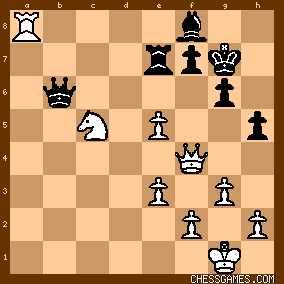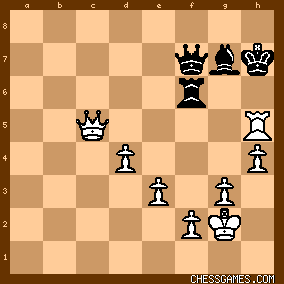|
< Earlier Kibitzing · PAGE 3 OF 3 ·
Later Kibitzing> |
| Sep-14-13 | | thegoodanarchist: <romni: I tend to think that the Capablanca v Alekhine match has similarities with the Spasskyv Fischer match, where the fanatical workaholic overcame the natural talent.Incidentally, the eventual winner of the respective matches had never previously won a game against that opponent!> And Kasparov had never beaten Karpov until this game, when he was down 5-0 in their first WC match: Kasparov vs Karpov, 1984 |
|
Sep-15-13
 | | offramp: < PinkZebra: This game really shows Capablanca's endgame skill and Alekhine's poor endgame technique. He must of been drunk!> Must he of? |
|
| Sep-16-13 | | aliejin: Romanovsky wrote that, after this game,
, Where capablanca played perfect chess and
, However, Alekhine showed a resistance colossal
to the point that almost tied, it was clear for him
( romanovsky ) Alekhine would win
the match |
|
| Dec-02-13 | | Owl: Capablanca escapes with a win in an equal position. |
|
| Nov-27-14 | | thegoodanarchist: <Knight13: Capablanca knew that Knights are better when there are pawns on only one side of the board, and he only needed an extra pawn to win after bullying that b6 guy to death.> Was a knight ever better posted in a WCC match than here, on move 52? 52.Nc6 and wins. |
|
| Nov-27-14 | | thegoodanarchist: < Owl: Capablanca escapes with a win in an equal position.> You are new to chess, right? |
|
Nov-28-14
 | | Sally Simpson: :)
Capablanca was always escaping with wins in equal positions. He escaped with wins from this position...

click for larger view...hundreds of times from both sides of the chessboard. He was one regular Chess Houdini. |
|
Nov-28-14
 | | plang: <Sally Simpson: :)
Capablanca was always escaping with wins in equal positions. He escaped with wins from this position..>
Good point - great players try to win in even the most "simple" of positions. If you can outplay someone from move 1 why not outplay someone from move 60? |
|
| Jul-12-15 | | Calli: GM Alejandro Ramirez gives a wonderful explanation of this endgame: https://www.youtube.com/watch?v=ziC... |
|
| Dec-22-15 | | Howard: Where was the point of no return, as far as when Alekhine lost the draw for good ? |
|
Dec-22-15
 | | beatgiant: <Howard>
Read the very first post on this game: <Dec-14-02 Sabatini: Alekhine gave JR Capablanca a chance to get equal the match by playing 55...Kg5 over 55...Bd6.> |
|
| Dec-07-16 | | andrea volponi: 56...Aa3!!-d6 Rf6-d7 Re7-Cxf7 Rxd7-Ce5+ Re6-Cxg6 Rf6-Cf4 Rg5-Cg2 |
|
| Dec-07-16 | | ChessHigherCat: Capa really toys with Alekhine here like a little kid, especially in the end game. So much for the idea that a bishop is worth more than a knight. You can just imagine Alekhine trying to intimidate Capa and lure him into cheap traps like some belligerent blitz hustler, while Capa autistically and artistically ignores him, pursuing his own plan as cool as a cryogenic cucumber. |
|
| Jul-05-17 | | Petrosianic: <Howard>: <Where was the point of no return, as far as when Alekhine lost the draw for good ?> No later than 56...Bd4?
The problem with this move is that it lets White have the f pawn. 57. Nxf7+ Kf6 58. Nd8, and now if Black plays Ke5 to pick up White's d pawn, White has 59. Nc6+! Black gets his pawn back only at the cost of letting White exchange minors (only possible because the Bishop is on d4), and get into a won K+P ending. On the other hand, Black may have been lost already. Suppose instead Black plays something like 56...Ba3. In that case, 57. d6 Kf6 58. d7 Ke7 59. Nxf7 Kxd7 60. Ne5+, and White is two pawns up and surely winning anyway. So maybe it was earlier. |
|
| Jul-05-17 | | Petrosianic: I just deciphered andreavolponi's cryptic post. Correcting for the horrible formatting and foreign piece labels, it looks like he gave the same line I did at the end, 56...Ba3 57. d6 Kf6 58. d7 Ke7 59. Nxf7 Kxd7 60. Ne5+, continuing with 60....Ke6 61. Nxg6 Kf6 62. Nf4 Kg5 63. Ng2. I'm not sure what his point was as he posted no words, only a computer line. He gave two exclams to 56...Ba3, then gave a line that ended up with Black two pawns down and apparently lost (so why the exclams?). I don't think his 63. Ng2 is best though. White needs to do a little work to untangle his pawn structure. Maybe 63. Nd5 Bc4 64. Ne3! Ba7 65. Ke4 Bb8 66. f3 and White must be winning. |
|
Jul-05-17
 | | beatgiant: <Howard>
Some kibitzing above gave 55...Kg5 as the losing move, suggesting instead 55...Bd6 or 55...Bb6 and claiming a draw. |
|
| Jul-05-17 | | Petrosianic: Yeah, Kg5 may be the losing move. Come to think of it, I've heard that claimed before, but haven't checked it out. It seems that the losing point must be when Black is sure to lose the second pawn. It's hard to believe he was lost when the Queens came off. |
|
Jul-06-17
 | | beatgiant: <when Black is sure to lose the second pawn> 55...Kg5 definitely loses at least a second pawn, because 56. Ne5 hits f7 while also threatening to push d6 (supported by the potential fork with ...Bxd6 Nf7+) and the further advance of the d-pawn would cost a bishop, while 56...Kf6 57. Nd7+ is another fork. <whiteshark> above gave a fairly convincing example line for 55...Bb6 ending in a draw. |
|
| Sep-01-17 | | andrea volponi: 56...Ba3 (very good drawing chances -fred reinfeld ,kasparov etc... )-d6 Kf6 -d7 Ke7 -Nxf7 Kxd7 -Ne5+ Ke6 -Nxg6 Kf6 -Nf4 Kg5 - Nd5 (wins in 42( Ng2 wins in 42)) Bc5 (Bd6 lose in 41) -Ne3 Ba7 (...Bb4;Ba3;Bd6;Be7;Bf8 lose in 40) -Ke4 wins in 40 moves |
|
| Jun-18-18 | | Omnipotent00001: 61. g5+ is mate in 24. |
|
| Nov-03-18 | | CharlesSullivan: < Mystery of the Unpunished Blunder [Beginning] >
Of course, Alekhine's blunder at move 55 (...Kg5) was very nicely punished by Capablanca. But there's a tiny voice through the ages that says that Capablanca must have failed to take advantage of an earlier mistake.
According to Alekhine, Capablanca thought that 38.Ne5 was the "only moment at which he could have forced a win." But Alekhine himself showed that to be untrue.
Kasparov seems to despair of finding the elusive error. At move 31 he writes, "It is pointless to try and exhaust the given position by variations -- it seems to me that objectively it is closer to a loss for Black than to a draw." A dozen moves later he observes, "White has chosen the most straightforward plan: the creation of a passed pawn on the d-file. But the paradoxical thing is that in the process his advantage gradually evaporates!"
It turns out that 36...Bf8 (instead of 36...Bb8!) allows a winning move that nobody has suggested: 37.Nc5!! <+4.84, depth 60, 8 hours>:

click for larger view
Why did Capablanca pass on this move?
[A]
Perhaps the players thought that 37...Bxc5 would leave White with an isolated c-pawn which could be easily blockaded, leading to a sure draw. But White wins quickly: 37.Nc5 Bxc5 38.dxc5 Kh7
[the blockade with 38...Rc7 loses immediately to 39.Ra8]
39.Rd6 Rb5 40.Qf4 Qb7+ 41.c6 Qc7 42.Qd4 Ra5 43.e4 e5 44.Qd3 Kg7 45.Rd5 Ra2 46.Qc4 Qa7 47.Rc5 Qa3

click for larger view
48.Qxa2!!
[B]
Shoring up defense of the e6-pawn just loses another pawn: 37.Nc5 Re7 <+4.90, depth 64> 38.Ra8 Qc7 39.Qf3 Kg7 40.Kg1 Qb6 41.Qf4 e5 42.dxe5!

click for larger view
If 42...Qxc5, then 43.Qf6+ Kg8 44.Rxf8+! Kxf8 45.Qh8# [C]
Also: 37.Nc5 Rb5 38.Ra8 <+5.30, depth 63> Qc7 39.Qf3 Rb6 40.Ne4 Qb7 41.Rd8 Kg7 42.Qf6+ Kg8 43.d5 exd5 44.Nd6 d4+ 45.Kh3 Qc7 46.Ne8! wins:

click for larger view
If 46...Rxf6 then 47.Nxf6+ Kh8 48.Rxf8+ Kg7 49.Ne8+ Kxf8 50.Nxc7 d3 51.Nd5 and the knight will stop Black's d-pawn just in time. [To be continued ...] |
|
| Nov-03-18 | | CharlesSullivan: < Mystery of the Unpunished Blunder, [Conclusion] > [D]
The main line is 37.Nc5! Rb8 <+5.30, depth 65, 15 hours> 38.Rc6 Qe8 39.Nxe6!!

click for larger view
39...fxe6 40.Rxe6 Qf7 41.Rxg6+ Bg7 42.Rg5 Rb6 43.h4! <+7.19>

click for larger view
Black's defenses are no match for White's pawn phalanx; the finish might be 43...Rd6 44.Qc2 Kh8 45.Qc8+ Kh7 46.Qc5 Rf6 47.Rxh5+

click for larger view
and White's position is obviously winning.
After Capablanca missed 37.Nc5!, the win was gone; Alekhine did not stumble again until his 55th move. |
|
| Jul-16-23 | | N.O.F. NAJDORF: I wonder why black did not play
21...Nd7 |
|
| Jul-16-23 | | N.O.F. NAJDORF: ... and also
22...c5 |
|
Aug-13-24
 | | plang: In the 11th game Capablanca had played 12 Be2 and had gone on to win; 12 g3 was new and seems like an improvement as when the bishop is moved to the h1-a8 diagonal the f-pawn will not be blocked. Alekhine's plan of 14..b6 and 15..a5?! created queenside weaknesses; passive defense with ..Rfd8, ..Rac8 and ..Be8 would have been better. 21..b5 was suggested as an improvement which would have prevented Capablanca's strong 22 b5!. 34..Qb7? 35 Ra8+..Bf8 36 Qxb7..Rxb7 37 Rd8 would have been winning for White. After a long, heroic defense Alekhine blundered with 55..Kg5? which cost him the game. 60 Kf4! was a pretty pawn sacrifice that led to the final breakthrough. |
|
 |
 |
|
< Earlier Kibitzing · PAGE 3 OF 3 ·
Later Kibitzing> |





































